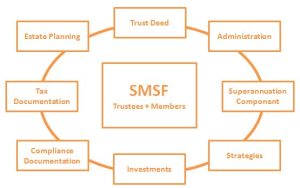How Much Money is Required for SMSF?
Understanding Self-Managed Superannuation Funds (SMSF)
When it comes to planning for your retirement, Self-Managed Superannuation Funds (SMSF) have become an increasingly popular choice among Australians. SMSFs provide individuals with greater control over their retirement savings, allowing for a more customized investment strategy. However, one of the most crucial questions potential SMSF trustees ask is, “How much money is required to set up and maintain an SMSF?” In this comprehensive guide, we will delve into the various factors that influence the cost of establishing and managing an SMSF, ensuring that you have a clear understanding of the financial commitment involved.

The Initial Costs of Setting Up an SMS
Setting up an SMSF involves several upfront costs that need to be considered. These costs may include:
Establishment Costs
The establishment costs of an SMSF typically include:
- Trust Deed: The trust deed is a legal document that outlines the rules and regulations governing the fund. You may need to pay for the creation of a trust deed, which can range from a few hundred to a few thousand dollars, depending on whether you use a template or seek legal advice.
- Professional Services: Many individuals choose to engage professional services, such as an accountant or financial advisor, to help with the initial setup. These services can incur additional costs that vary based on your specific requirements and the professional’s fees.
Legal and Compliance Costs
An SMSF must adhere to strict legal and compliance requirements. These costs include:
- Australian Business Number (ABN) and Tax File Number (TFN) Application: To operate legally, your SMSF will need an ABN and TFN. The Australian Taxation Office (ATO) provides these numbers at no cost.
- Annual ASIC Fee: The Australian Securities and Investments Commission (ASIC) charges an annual fee to regulate SMSFs. The cost of this fee can vary.
- Audit Fees: An annual audit is a mandatory requirement for SMSFs, and audit fees can range from a few hundred to over a thousand dollars, depending on the complexity of the fund.
Investment Costs and Contribution Requirements
Apart from the initial setup costs, you should also consider the investment costs and contribution requirements for an SMSF. These costs can include:
Investment Expenses
- Brokerage Fees: If your SMSF invests in shares or other assets on the stock market, you will incur brokerage fees each time you buy or sell assets.
- Investment Management Fees: If you choose to invest in managed funds or other investment vehicles, you may be subject to ongoing management fees, which vary based on the fund’s structure.
Contribution Requirements
- Minimum Balance: While there is no strict requirement for the minimum balance to set up an SMSF, it’s important to remember that SMSFs with higher balances can be more cost-effective. Having a lower balance could mean that fees and costs will eat into your retirement savings more significantly.
- Contribution Caps: The ATO imposes contribution caps on how much you can contribute to your SMSF each year. Exceeding these limits can result in additional taxes.
Ongoing Administrative Costs
Maintaining an SMSF involves ongoing administrative costs, which should not be overlooked. These include:

Administration and Accounting Fees
- Accounting Fees: SMSFs require regular accounting and financial reporting to meet regulatory requirements. The cost of these services will vary based on the complexity of your fund and the fees charged by your accountant.
- Financial Advice: Many SMSF trustees seek financial advice to ensure their investment strategy aligns with their retirement goals. Financial advice fees can vary depending on the services you require.
Insurance Costs
- Life Insurance and Other Coverage: It’s essential to consider the cost of life insurance or other types of coverage for the members of the SMSF. These costs will depend on factors like age, health, and the level of coverage chosen.
Conclusion: How Much Money Do You Need for an SMSF?
The amount of money required to set up and maintain an SMSF varies greatly based on individual circumstances and investment goals. While there is no strict minimum balance required to establish an SMSF, it’s crucial to consider all the associated costs, including establishment, legal and compliance, investment, and ongoing administrative expenses.
To ensure the success of your SMSF and make an informed decision about whether it’s the right choice for your retirement, seeking professional advice is highly recommended. A qualified financial advisor or accountant can help you assess your financial situation and provide guidance on the most cost-effective approach to managing your self-managed superannuation fund.
In summary, the cost of an SMSF can range from a few thousand dollars to several thousand dollars annually. It’s essential to budget accordingly and carefully consider your investment strategy to make the most of your retirement savings. By understanding the financial commitment involved in an SMSF, you can make well-informed decisions that align with your retirement goals and aspirations. Find us here.


